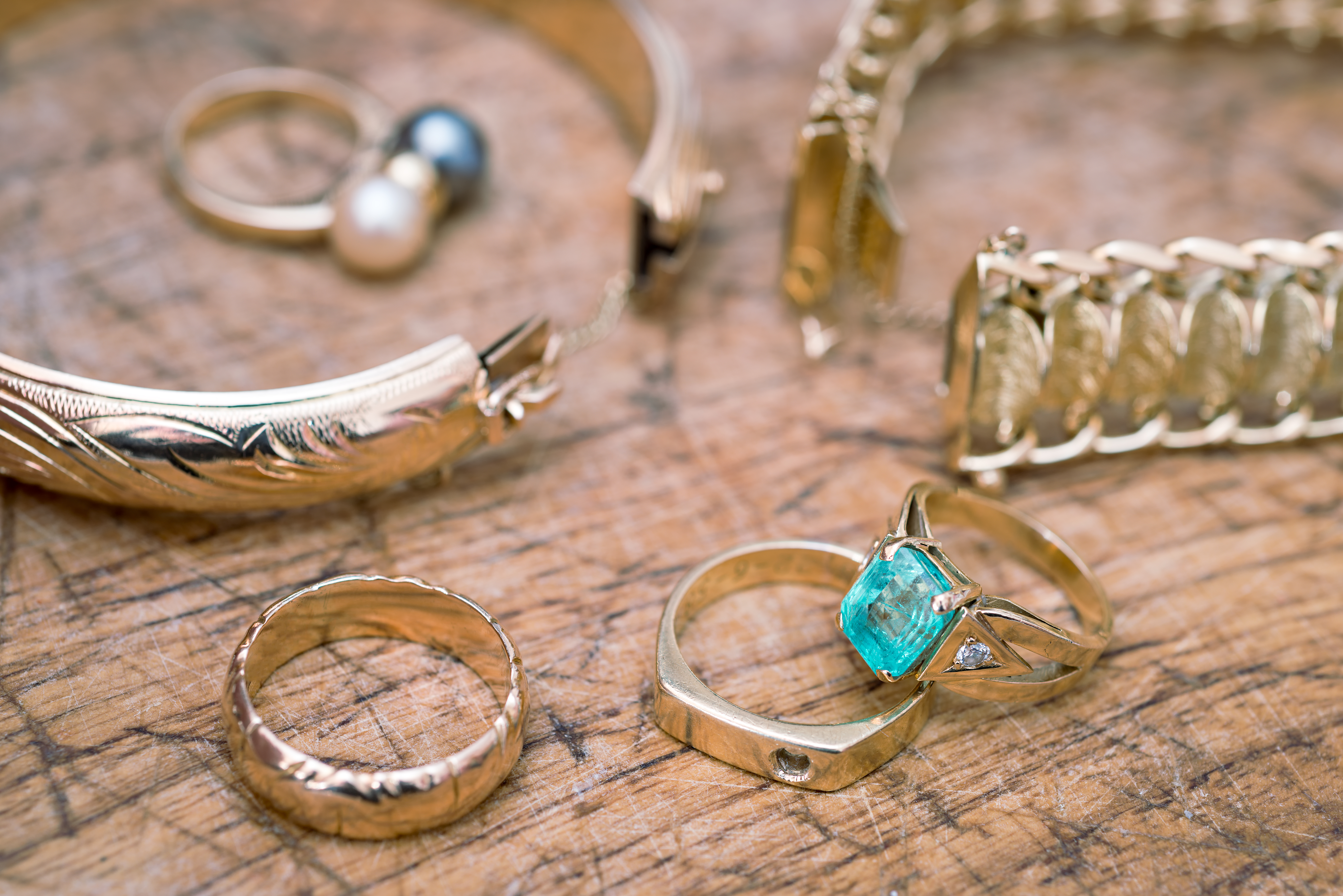
Jewelry Glossary
Here are the definitions of many commonly used jewelry terms.
Alloy
The mixture of two or more metals which strengthens the metal, and/or enhances its appearance.
Bangle
A bracelet that is rigid and slides over the hand. Bangle bracelets sometimes don't have a clasp.
Bead Setting
Diamonds or color gemstones are set evenly with the surface of the metal, and secured by bead-like prongs between the stones.
Bezel Setting
A diamond or gemstone is wrapped with the metal, where only the crown and table can be seen.
Blemish
An imperfection on the surface of a diamond.
Brilliance
The amount of sparkle or shine which is reflected from the diamond.
Cabochon
A gemstone cut which is polished into a smooth, rounded dome-like surface, instead of having facets.
Carat Weight
A diamond's measurement for weight, which is equal to 0.2 grams, as described in the four Cs of diamonds.
Cathedral Setting
A setting that has cathedral-like arches on each side of the diamond or gemstone.
Channel Setting
Diamonds or color gemstones are set adjacent to one another and are held in by a channel of metal, with no metal between each stone.
Clasp
A device which is used to fasten the end of chains, necklaces, bracelets and watches.
Cleavage
Cracks, openings, or fractures in diamonds or color gemstones.
Cluster Setting
Diamonds or color gemstones are grouped together and are arranged to give the impression of one large stone.
Crown
The upper part of a diamond or gemstone, beneath the table and above the girdle.
Culet
The small facet on the bottom point of a diamond, beneath the pavilion. Not all diamonds have a culet.
Facets
The flat surfaces on a diamond or color gemstone. The arrangement of a gemstone's facets determine its cut and return of light.
Fire
The flashes of color that can be seen when a diamond or gemstone is moved or rotated.
Flawless
The highest grading on the diamond clarity scale, which has no visible inclusions or blemishes under 10x magnification.
Flush Setting
A hole is created in the metal surface, and a diamond or gemstone is placed inside, where its table is evenly set with the surface of the metal.
Four Cs
The four characteristics of a diamond - color, clarity, cut and carat weight - which are used to establish the quality and value of diamonds.
Girdle
The outer edge of a diamond where the crown (top) meets the pavilion (bottom part).
Hardness
The ability of a diamond or gemstone to resist scratches, which is measured using the Moh's scale of hardness from 1-10, with 10 being the hardest.
Ideal Cut
An ideal cut diamond has the highest quality of proportions, symmetry and polish, and returns almost all the light that enters it.
Inclusions
The natural unique \"fingerprints\" within a diamond or gemstone, which consist of other elements such as minerals, gases, or other substances.
Burnished (Flush) Setting
Diamonds or color gemstones are set flush within the surface of the metal, where a part of the metal setting is cut away and replaced by the stone and the metal around the stone is pushed down to hold it in.
Invisible Setting
Diamonds or gemstones are set in an arrangement where the metal cannot be seen, making it appear as if there is no setting holding the stones.
Karat
The standard measurement for gold, where 24 karats is pure gold. 14-karat or 18-karat gold is mixed with other metal alloys to strengthen it, and to enhance its appearance.
Moh's Scale
The scale which is used to measure the hardness of a diamond or gemstone, or its resistance to scratches, ranging from 1-10, with 10 being the hardest.
Pavé Setting
Small diamonds or color gemstones are held in place by small handcrafted prongs, where all the tables of the stones are set evenly with the metal surface.
Pavilion
The bottom portion of a diamond, between the girdle and the culet.
Pink Gold
Pink gold is created when pure gold is combined with more copper than other alloys, and is often called rose gold.
Polish
The amount of smoothness, or shininess on a metal's surface. The more polished, the more light reflects off a metal's surface.
Play of Color
The spectral colors that can be seen in an opal when it is rotated or moved.
Prong Setting
A diamond or gemstone is mounted in the metal with prongs that wrap around its girdle, and are usually secured to the crown of the stone.
Proportions
The relationship of a diamond's parts to one another, such as crown angle, crown height and table percentage, which ultimately determine a stone's brilliance.
Scintillation
The flashes of light that can be seen in a diamond when rotated under a natural or artificial light source.
Solitaire
Rings, pendants, earrings, bracelets, or necklaces that feature one diamond in its setting.
Symmetry
The precision of the alignment of a diamond's facets. The more symmetrical, the better the return of light.
Table
The flat surface on the top of a diamond or gemstone.
Tension Setting
A setting where the diamond or gemstone seems to be floating between two pieces of metal, but is actually held in by compression.
Toughness
The ability of a diamond or gemstone to resist breakage (or fracturing) from impact.
Vermeil
Fine silver jewelry that is electroplated with a layer of gold.
White Gold
Made by combining pure gold with copper, zinc and nickel (or palladium) alloy, and then plated with rhodium for the bright white color.
Yellow Gold
Gold that retains its natural yellow color. Pure gold is typically combined with copper and silver alloys to enhance its durability.
The mixture of two or more metals which strengthens the metal, and/or enhances its appearance.
Bangle
A bracelet that is rigid and slides over the hand. Bangle bracelets sometimes don't have a clasp.
Bead Setting
Diamonds or color gemstones are set evenly with the surface of the metal, and secured by bead-like prongs between the stones.
Bezel Setting
A diamond or gemstone is wrapped with the metal, where only the crown and table can be seen.
Blemish
An imperfection on the surface of a diamond.
Brilliance
The amount of sparkle or shine which is reflected from the diamond.
Cabochon
A gemstone cut which is polished into a smooth, rounded dome-like surface, instead of having facets.
Carat Weight
A diamond's measurement for weight, which is equal to 0.2 grams, as described in the four Cs of diamonds.
Cathedral Setting
A setting that has cathedral-like arches on each side of the diamond or gemstone.
Channel Setting
Diamonds or color gemstones are set adjacent to one another and are held in by a channel of metal, with no metal between each stone.
Clasp
A device which is used to fasten the end of chains, necklaces, bracelets and watches.
Cleavage
Cracks, openings, or fractures in diamonds or color gemstones.
Cluster Setting
Diamonds or color gemstones are grouped together and are arranged to give the impression of one large stone.
Crown
The upper part of a diamond or gemstone, beneath the table and above the girdle.
Culet
The small facet on the bottom point of a diamond, beneath the pavilion. Not all diamonds have a culet.
Facets
The flat surfaces on a diamond or color gemstone. The arrangement of a gemstone's facets determine its cut and return of light.
Fire
The flashes of color that can be seen when a diamond or gemstone is moved or rotated.
Flawless
The highest grading on the diamond clarity scale, which has no visible inclusions or blemishes under 10x magnification.
Flush Setting
A hole is created in the metal surface, and a diamond or gemstone is placed inside, where its table is evenly set with the surface of the metal.
Four Cs
The four characteristics of a diamond - color, clarity, cut and carat weight - which are used to establish the quality and value of diamonds.
Girdle
The outer edge of a diamond where the crown (top) meets the pavilion (bottom part).
Hardness
The ability of a diamond or gemstone to resist scratches, which is measured using the Moh's scale of hardness from 1-10, with 10 being the hardest.
Ideal Cut
An ideal cut diamond has the highest quality of proportions, symmetry and polish, and returns almost all the light that enters it.
Inclusions
The natural unique \"fingerprints\" within a diamond or gemstone, which consist of other elements such as minerals, gases, or other substances.
Burnished (Flush) Setting
Diamonds or color gemstones are set flush within the surface of the metal, where a part of the metal setting is cut away and replaced by the stone and the metal around the stone is pushed down to hold it in.
Invisible Setting
Diamonds or gemstones are set in an arrangement where the metal cannot be seen, making it appear as if there is no setting holding the stones.
Karat
The standard measurement for gold, where 24 karats is pure gold. 14-karat or 18-karat gold is mixed with other metal alloys to strengthen it, and to enhance its appearance.
Moh's Scale
The scale which is used to measure the hardness of a diamond or gemstone, or its resistance to scratches, ranging from 1-10, with 10 being the hardest.
Pavé Setting
Small diamonds or color gemstones are held in place by small handcrafted prongs, where all the tables of the stones are set evenly with the metal surface.
Pavilion
The bottom portion of a diamond, between the girdle and the culet.
Pink Gold
Pink gold is created when pure gold is combined with more copper than other alloys, and is often called rose gold.
Polish
The amount of smoothness, or shininess on a metal's surface. The more polished, the more light reflects off a metal's surface.
Play of Color
The spectral colors that can be seen in an opal when it is rotated or moved.
Prong Setting
A diamond or gemstone is mounted in the metal with prongs that wrap around its girdle, and are usually secured to the crown of the stone.
Proportions
The relationship of a diamond's parts to one another, such as crown angle, crown height and table percentage, which ultimately determine a stone's brilliance.
Scintillation
The flashes of light that can be seen in a diamond when rotated under a natural or artificial light source.
Solitaire
Rings, pendants, earrings, bracelets, or necklaces that feature one diamond in its setting.
Symmetry
The precision of the alignment of a diamond's facets. The more symmetrical, the better the return of light.
Table
The flat surface on the top of a diamond or gemstone.
Tension Setting
A setting where the diamond or gemstone seems to be floating between two pieces of metal, but is actually held in by compression.
Toughness
The ability of a diamond or gemstone to resist breakage (or fracturing) from impact.
Vermeil
Fine silver jewelry that is electroplated with a layer of gold.
White Gold
Made by combining pure gold with copper, zinc and nickel (or palladium) alloy, and then plated with rhodium for the bright white color.
Yellow Gold
Gold that retains its natural yellow color. Pure gold is typically combined with copper and silver alloys to enhance its durability.
